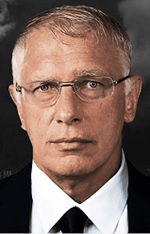 En la bóveda principal del Panteón de París, suspendido en la altura, oscila el péndulo construido por León Foucault en el siglo XIX para demostrar el movimiento de rotación de la Tierra. La ley del péndulo determina, no solo esa acción mecánica (que corresponde a la reacción contraria de fuerza equivalente) en el péndulo, sino en objetos como el columpio.
En la bóveda principal del Panteón de París, suspendido en la altura, oscila el péndulo construido por León Foucault en el siglo XIX para demostrar el movimiento de rotación de la Tierra. La ley del péndulo determina, no solo esa acción mecánica (que corresponde a la reacción contraria de fuerza equivalente) en el péndulo, sino en objetos como el columpio.
La ley del péndulo no es otra que la de causa y efecto ilustrada también en el flujo y reflujo de los mares. Como toda ley, la del péndulo evita que los extremos salgan despedidos por el aire o revienten la cuerda que los suspende, cuando es su turno de balancear el movimiento. La duración o amplitud de la curva depende de las fuerzas de oposición.
En la Enciclopedia de la política el jurista y expresidente de Ecuador, Rodrigo Borja (1935) explica el efecto péndulo como la manera gráfica de referirse al movimiento dialéctico que suele producirse en el vaivén político de los pueblos.
En la política, es la fuerza opositora la que provee ese equilibrio. Unas veces detienen el extremismo conservador y otros el liberal. El problema es que cuando uno de esos extremos se aferra al poder, el hilo de donde cuelga el péndulo se enreda o revienta. Es ahí donde se producen las revoluciones o las guerras civiles.
De derecha a izquierda y viceversa
La historia contiene muchos eventos de antagonismos insalvables, como el de la democracia contra las dictaduras e ideologías de hoy en día. Ejemplo más reciente es el de las conocidas tendencias de izquierda y derecha y sus extremismos: la ultra derecha y la ultra izquierda.
- Hits: 535

 prensa fuerte y crítica, y ciudadanos que no teman ponerse de pie y decir que el emperador está desnudo. O, por el contrario, defender a las víctimas de la propaganda y la mentira. Es este un momento en que escritores y periodistas deben estar más claros y saber distinguir la verdad de la falsedad, la noticia de la farsa y la difamación política, y aliarse con la verdad. Aquel que teme hacerlo no es un pensador libre.
prensa fuerte y crítica, y ciudadanos que no teman ponerse de pie y decir que el emperador está desnudo. O, por el contrario, defender a las víctimas de la propaganda y la mentira. Es este un momento en que escritores y periodistas deben estar más claros y saber distinguir la verdad de la falsedad, la noticia de la farsa y la difamación política, y aliarse con la verdad. Aquel que teme hacerlo no es un pensador libre. Estamos al borde de una guerra civil en Estados Unidos. No creo que sea armada pero sí en los tribunales y en los medios de prensa. Una nación profundamente dividida en la que cualquiera que piense distinto es un "enemigo". Lo estamos percibiendo en las elecciones que se avecinan en el país. No importa qué lado gane, el otro lado se mostrará amarga y tal vez violentamente infeliz. Las elecciones de noviembre este año 2024 serán impugnadas de varias maneras por el perdedor, cualquiera que sea. Es probable que sea una situación caótica y muy fea. Cierto que parece algo escandaloso de decir, pero ya lo estamos viendo en la campaña electoral y no podemos seguir ignorándolo con una actitud de indefensión.
Estamos al borde de una guerra civil en Estados Unidos. No creo que sea armada pero sí en los tribunales y en los medios de prensa. Una nación profundamente dividida en la que cualquiera que piense distinto es un "enemigo". Lo estamos percibiendo en las elecciones que se avecinan en el país. No importa qué lado gane, el otro lado se mostrará amarga y tal vez violentamente infeliz. Las elecciones de noviembre este año 2024 serán impugnadas de varias maneras por el perdedor, cualquiera que sea. Es probable que sea una situación caótica y muy fea. Cierto que parece algo escandaloso de decir, pero ya lo estamos viendo en la campaña electoral y no podemos seguir ignorándolo con una actitud de indefensión.

 Doug Casey: The middle class, the bourgeoisie, emerged with the death of feudalism, the inception of the Renaissance, the Enlightenment, and finally, the Industrial Revolution.
Doug Casey: The middle class, the bourgeoisie, emerged with the death of feudalism, the inception of the Renaissance, the Enlightenment, and finally, the Industrial Revolution.